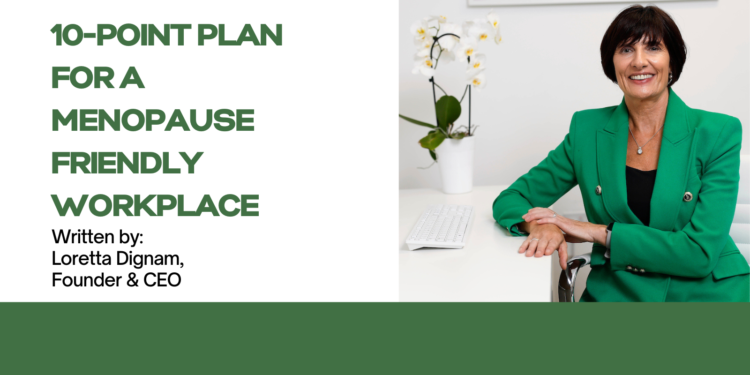Written by Loretta Dignam, Founder & CEO, The Menopause Hub
I set up The Menopause Hub – Ireland’s first-ever clinic solely devoted to helping women through the menopause and perimenopause – after finding out for myself the appalling lack of help available to women in their 40s and 50s whose bodies were beginning to change.
Later, I discovered that many highly qualified women in Ireland with significant talent and experience were either quitting – or on the brink of walking out on – successful careers simply because they were finding their menopause symptoms overwhelming and were not being supported by their employer.
4 in 10 women considered giving up work or cutting back their hours. And 1 in 10 women have left work due to symptoms. Employers cannot afford this loss of talent.
Menopause in the workplace remains an “overlooked cultural taboo that is mistakenly swept under the carpet”.
But the problem simply won’t go away if we just ignore it.
Some major – and forward-thinking – employers across Ireland and the UK are introducing menopause training programmes because they understand they must adapt if they want to retain highly skilled and experienced female employees.
They know it makes perfect business sense for them to do so.
A large number of organisations, however, remain behind the curve – but they can easily get up to speed by following this simple 10-point plan:

1. First things first, speak to your staff by conducting focus groups or surveys. A confidential survey is an effective way to gauge attitudes across the workplace. Follow-up surveys can be carried out to evaluate the effectiveness of any subsequent training programmes.
2. Formulate a menopause policy for the organisation. But make sure it is communicated to everyone in the workforce after doing so, and that it becomes a living document which is regularly revisited and updated. Do not leaving it on the shelf, gathering dust. And make sure that it integrates with your other workplace policies.
3. Begin menopause awareness training programmes. These will help normalise the conversation around menopause. Education is key to eradicating any embarrassment people may have about discussing this complex subject. Menopause awareness for all colleagues will open up the conversation.
4. Appoint Menopause Champions. Mental health first aiders are now commonplace in workplaces and act as a listening ear and sign-poster for employees. Menopause Champions can perform a very similar role and be the first port of call for any staff struggling with symptoms. However menopause training is essential for Menopause Champions.
5. Make sure senior executives show their support for new initiatives. Change begins at the top, therefore it is vital that your menopause in the workplace programme enjoys the strong and visible backing of the senior ranks. If senior leaders can talk about their direct or indirect experience of menopause this will give permission for others to open up. Don’t under estimate the power of senior role model in the menopause conversation.
6. Involve male employees. Male allies are vital because menopause impacts us all, directly or indirectly at some point in our lives – it is not solely a woman’s issue.
7. Menopause training for line managers and supervisors. Management needs to know exactly what the symptoms of menopause are and how they can affect colleagues. Managers and supervisors need to feel confident discussing the impact of menopause and they need to know how to have a confidential and empathetic conversation with their team members. They also need to understand the range of supports, reasonable accommodation and reasonable adjustments available.
8. Training for the HR team is also required. Employers need to understand the legal implications of not responding appropriately to the problems faced by staff experiencing menopause or perimenopause. In addition, risk assessments may be necessary for some roles as well as involvement of Occupational Health.
9. Be flexible. No two women are the same, and neither is their menopause. The introduction of reasonable adjustments and accommodations in the workplace will go a long way to help affected employees manage their menopause –and keep them in their jobs. Tailored support mechanisms could include flexible working arrangements, regular breaks, access to cold water, bathroom facilities, a restroom, cold running water, time off for medical appointments, ability to adjust temperature via air conditioning, a desk fan or a window, and paid leave of absence. For organisations where a uniform is required, a change in the design, fit, and fabric may be necessary.
10. EAP – Consider including menopause specific supports in employee assistance programmes. Some menopausal members of staff may require access to medical support, counsellors, and specialist menopause clinics.









